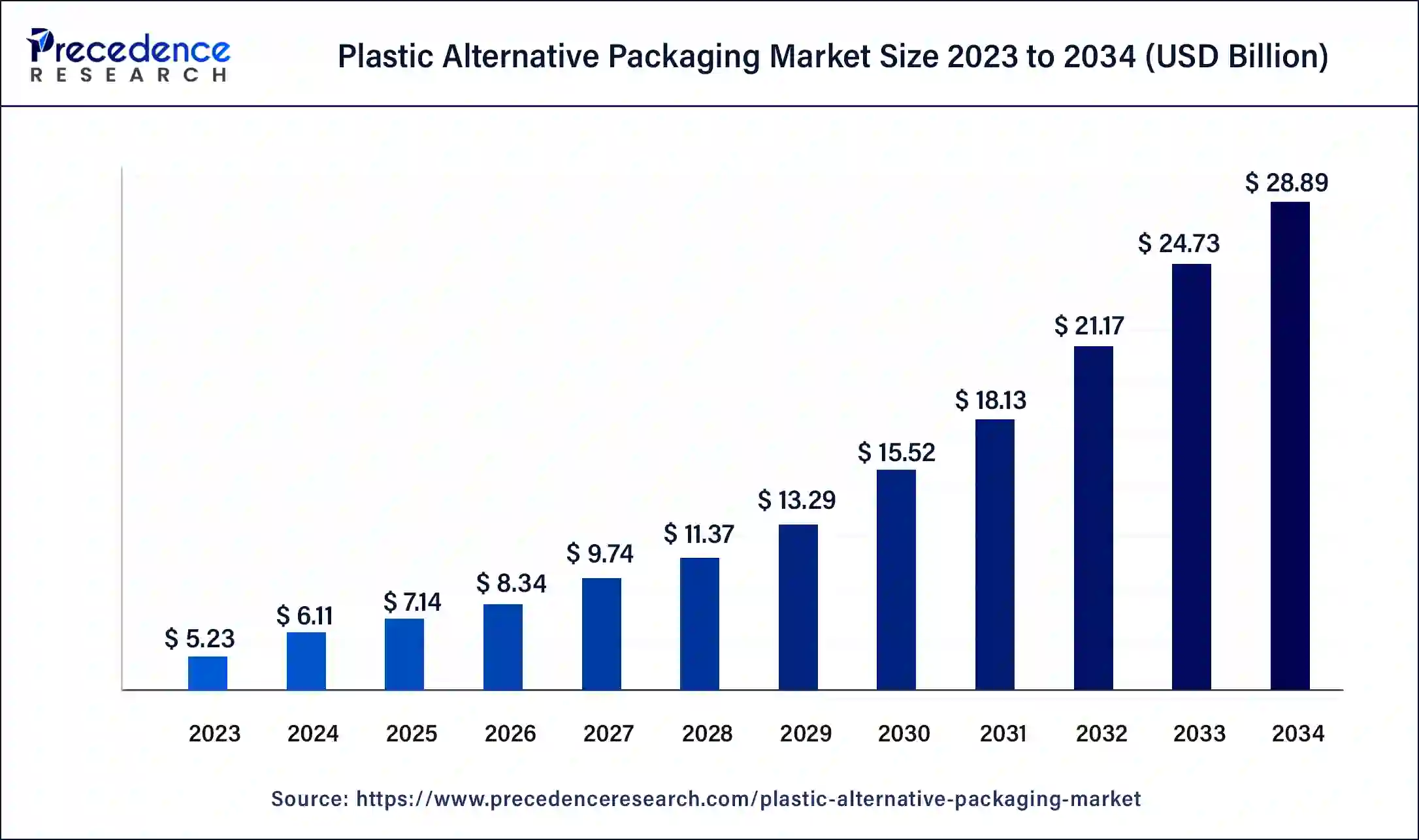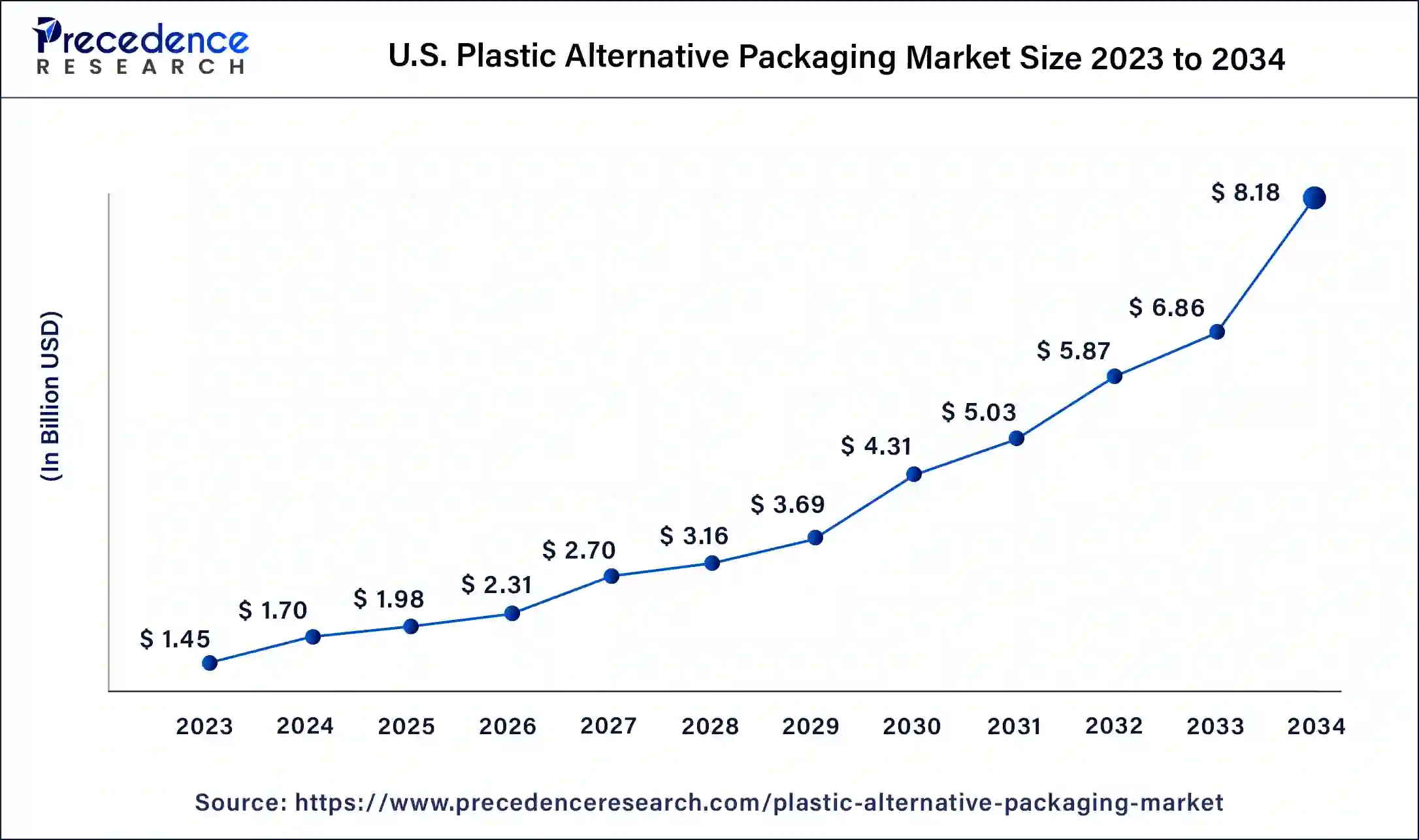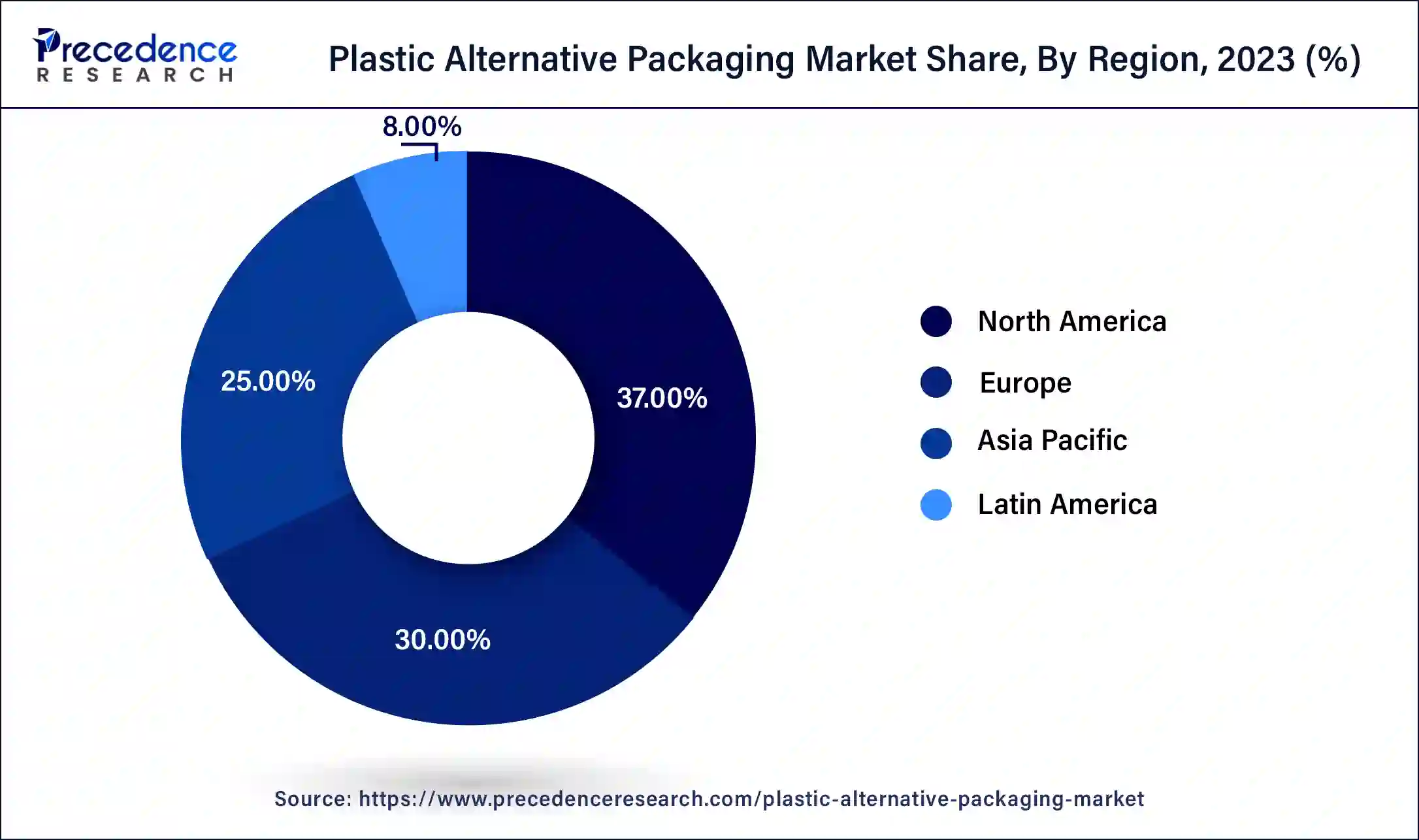List of Contents
Plastic Alternative Packaging Market Size and Forecast 2025 to 2034
The global plastic alternative packaging market size is projected to be worth around USD 28.89 billion by 2034 from USD 6.11 billion in 2024, at a CAGR of 16.81% from 2025 to 2034. The North America plastic alternative packaging market size reached USD 2.26 billion in 2024. The need for the plastic alternative packaging market is driven by rising environmental consciousness and regulatory demands surrounding plastic waste and its effects on the environment.

Plastic Alternative Packaging Market Key Takeaway
- The global plastic alternative packaging market was valued at USD 6.11 billion in 2024.
- It is projected to reach USD 28.89 billion by 2034.
- The plastic alternative packaging market is expected to grow at a CAGR of 16.81% from 2025 to 2034.
- North America the plastic alternative packaging market with the highest market share of 37% in 2024.
- Asia Pacific is expected to host the fastest-growing market during the forecast period.
- By type, the starch-based plastic segment held the largest share of the market in 2024.
- By type, the polylactic acid segment is expected to grow at the fastest rate in the market during the forecast period.
- By application, the food & beverages segment held the largest share of the market in 2024.
- By application, the healthcare segment is expected to grow at the fastest rate in the market during the forecast period.
What are the advantages of Artificial Intelligence in the Plastic Packaging?
The emergence of artificial intelligence in plastic management is helping to reduce waste production in the environment by developing advanced plastic packaging solutions. AI-driven sustainable packaging allows for the recycling of products. AI can identify plastic pollution sources like micro plastics in the ocean and can assist in innovation of packaging alternatives to plastics. Autonomous robotic systems are designed to assist in the clean-up of plastic-polluted oceans.
AI-assisted research helps to optimize waste collection, sorting, and disposal management along with innovations in plastic packaging designs based on the Internet of Things. AI-powered software assists in the analysis of targeted product sorting for the optimization of reprocessing or recycling.
- In July 2024, 2M Group based in the UK announced the launch of sustainable plastic solutions by addressing the supply of unnecessary petroleum-based plastics and focusing on biomaterial innovation strategies. It aims to enhance the customer experience by offering more sustainable bio-based solutions.
U.S. Plastic Alternative Packaging Market Size and Growth 2025 to 2034
The U.S. plastic alternative packaging market size was exhibited at USD 1.70 billion in 2024 and is projected to be worth around USD 8.18 billion by 2034, poised to grow at a CAGR of 17.01% from 2025 to 2034.

North America held the largest share of the plastic alternative packaging market in 2024. As sustainability gains traction, the market for plastic alternative packaging in North America is expanding rapidly. Recyclable alternatives, compostable materials, and biodegradable plastics are becoming more popular as ways to lessen environmental impact. This change is being driven by elements including consumer awareness, government legislation, and corporate sustainability aims. Biodegradable plastics, compostable materials, paper-based packaging, and reusable packaging options are important substitutes that are gaining popularity.
Adoption is also being influenced by elements like business sustainability objectives and customer preferences for sustainable products. These substitutes perform similarly to conventional plastics but have less of an adverse effect on the environment. In response to customer preferences for sustainable packaging solutions across a range of industries, including food and beverage, cosmetics, and pharmaceuticals, the industry is also witnessing breakthroughs in recycled materials and bio-based polymers.

Asia Pacific is expected to host the fastest-growing plastic alternative packaging market during the forecast period. The growing governmental push to reduce plastic usage and growing environmental concerns are driving growth in the Asia Pacific plastic alternative packaging market. Consumers' desire for environmentally friendly packaging options, government programs that support eco-friendly substitutes, and developments in material science are some of the main drivers of growth.
Among the substitutes being used are plant-based packaging, compostable materials, recycled paper, and biodegradable plastics. It is anticipated that this industry will grow significantly as businesses look to improve their sustainability profiles and tackle the problems associated with plastic waste worldwide. Growing consumer awareness and corporate sustainability objectives in a variety of sectors, including food and beverage, personal care, and pharmaceuticals, are other factors driving market expansion.
Market Overview
The plastic alternative packaging market is receiving a lot of attention as a result of growing environmental concerns and legislative pressure to use less plastic. Consumer demand for environmentally friendly packaging options and government programs that support sustainable practices are fueling the market's rapid growth in packaging alternatives made of plastic.
Biodegradable plastics like PLA and PHA, compostable plastics, paper-based packaging, glass, metal, and a variety of plant-based materials (including sugarcane and bamboo) are common substitutes for traditional plastics. Several industries, including food and beverage, personal care, pharmaceuticals, and home goods, use plastic substitute packaging. It includes forms of packaging such as trays, wraps, bottles, bags, and pouches.
The main factor influencing the use of plastic substitutes is their smaller environmental impact. Compared to conventional plastics, these materials can be recycled more effectively or disintegrate more readily in natural settings. Notwithstanding the advantages, there are still drawbacks, including more production costs than with traditional plastics, scarcer resources, and matching performance in terms of toughness and barrier qualities.
The market dynamics are influenced by different regulatory frameworks and adoption rates in different locations. Europe, for example, has strict laws supporting environmentally friendly packaging, but Asia Pacific is adopting it more quickly because of rising consumer awareness and financial incentives from the government. The plastic alternative packaging market is expanding due to ongoing advancements in material science and packaging technologies, as well as investments in R&D.
Plastic Alternative Packaging Market Growth Factors
- The need for the plastic alternative packaging market is driven by growing awareness of plastic pollution and its effects on the environment.
- The plastic alternative packaging market is driven by consumers' growing preference for environmentally friendly goods and packaging materials.
- The plastic alternative packaging market is growing because of government rules that encourage the use of recyclable, compostable, and biodegradable materials in packaging.
- As part of their corporate social responsibility (CSR) efforts, numerous businesses are implementing sustainable packaging solutions, which is driving market expansion.
- Plastic alternatives become more competitive when their performance and cost are improved by developments in materials science and packaging technology.
- The plastic alternative packaging market expansion is fueled by ongoing advancements in packaging materials, such as bioplastics, paper-based packaging, and reusable packaging options.
- The adoption of plastic substitutes is further fueled by worries about supply chain interruptions and the requirement for robust packaging solutions.
Market Scope
| Report Coverage | Details |
| Market Size by 2034 | USD 28.89 Billion |
| Market Size in 2025 | USD 7.14 Billion |
| Market Size in 2024 | USD 6.11 Billion |
| Market Growth Rate from 2025 to 2034 | CAGR of 16.81% |
| Largest Market | North America |
| Base Year | 2024 |
| Forecast Period | 2025 to 2034 |
| Segments Covered | Type, Application, and Regions |
| Regions Covered | North America, Europe, Asia-Pacific, Latin America and Middle East & Africa |
Market Dynamics
Driver
Corporate sustainability initiatives
Including post-consumer recycled material in packaging to encourage recycling and cut down on the use of virgin plastic. Putting money into the development of compostable or biodegradable packaging materials will help reduce the amount of plastic trash that ends up in landfills and the ocean. Creating packaging that is durable and functional while using the least amount of material possible to reduce the number of resources used.
Adopting the ideas of the circular economy by creating packaging that is simple to recycle or reuse, thereby lowering the need for virgin resources. Policies should be put in place to lessen the carbon impact of packaging distribution and production, such as energy-efficient manufacturing techniques and shipping. Ensuring the ethical sourcing of raw materials for packaging, taking into account supply chain effects on the environment and society.
Restraint
End-of-life handling
Numerous materials intended for recycling or composting, such as bioplastics, paper-based composites, and biodegradable plastics, are alternatives to plastic. Efficient recycling or composting of these items requires a suitable infrastructure for their collection, sorting, and processing. Certain bioplastics and other alternatives to plastic are made to decompose in commercial composting facilities. For these materials to have an environmental advantage, it is imperative that they be disposed of appropriately in composting streams. Even with attempts to reduce waste in landfills, certain things can still find their way there. For instance, biodegradable polymers may decompose faster than conventional plastics, lessening the environmental damage they do in landfills.
Opportunity
Recyclable materials
Biodegradable or compostable bioplastics are derived from sustainable biomass sources such as sugarcane, maize starch, or cellulose. That makes them eco-friendly. Widely utilized as packaging because they are biodegradable and recyclable. They work well with a variety of packaging materials, including boxes and bags. Glass is endlessly recyclable and keeps its quality over numerous recycling loops despite being heavier and more delicate than plastics. Steel and aluminum are recyclable metals that are used in packaging because they are strong and can keep products fresh. Several materials are used to produce packaging that is recyclable but has improved qualities like strength or barrier characteristics. Packaging has a smaller environmental impact when made of recycled plastic from post-consumer or post-industrial sources.
Type Insights
The starch-based plastic segment held the largest share of the plastic alternative packaging market in 2024. In the plastic substitute packaging market, starch-based polymers are becoming more and more popular as eco-friendly substitutes for conventional plastics. These ingredients come from plant-based, renewable sources of starch like cassava, corn, and potatoes. They are appropriate for a range of packaging applications since they have benefits over traditional plastics in terms of biodegradability and compostability.
Regulations encouraging sustainable packaging solutions and growing environmental concerns have led to an expansion of the market for starch-based plastics. Compared to conventional polymers made of petroleum, they are more environmentally beneficial because they are made from renewable resources like corn, wheat, or potatoes. Plastics based on starch have a lower impact on landfills and the ocean since they break down more quickly in natural settings.
The polylactic acid segment is expected to grow at the fastest rate in the plastic alternative packaging market during the forecast period. It's a thermoplastic that can be composted and biodegraded; it comes from renewable resources like sugarcane or maize starch. Because PLA decomposes in composting environments and has a lower environmental impact than petroleum-based plastics, it is becoming more and more popular as an environmentally friendly substitute for conventional plastics. PLA is being utilized more frequently in applications including food packaging, disposable tableware, and other single-use products where biodegradability and sustainability are important, according to the plastic alternative packaging market in North America.
Application Insights
The food & beverages segment held the largest share of the plastic alternative packaging market in 2024. The application of alternative materials, such as starch-based polymers and polylactic acid (PLA), spans multiple industries, including food and beverage, according to the plastic alternative packaging market. When compared to conventional plastics, these materials have a lower environmental impact and are biodegradable, which makes them appealing for packaging beverages and perishable foods. Packaging for dairy goods, snacks, bottled water, and even alcoholic beverages is using them more and more.
Consumer desire for environmentally friendly packaging options in the food and beverage sector is fueling the market's expansion. Food packaging is another area where starch-based polymers are used, offering a practical and environmentally suitable substitute. These patterns show how consumers' desire for environmentally friendly packaging options in the food and beverage sector is expanding.
The healthcare segment is expected to grow at the fastest rate in the plastic alternative packaging market during the forecast period. Healthcare plays a critical role in the plastic alternative packaging market, particularly as companies look for more environmentally friendly options. Due to their biodegradability and lower environmental effects, plastic alternatives like polylactic acid (PLA) and starch-based plastics are becoming more and more popular.
These substitutes can be applied to the packaging of pharmaceuticals, medical equipment, and other healthcare supplies in the medical field to help cut down on plastic waste in clinics and hospitals. Manufacturers are putting more and more effort into creating bio-based and biodegradable products that promote sustainability objectives while satisfying the strict safety and regulatory standards of the healthcare industry. Healthcare providers are searching more and more for packaging materials that are less harmful to the environment than standard plastics, such as those that are compostable and biodegradable.
Plastic Alternative Packaging Market Companies
- Amcor Plc
- Mondi
- DS Smith
- Sealed air
- Tetra pak international SA
- Ball corporation
- WestRock
- Huhtamaki
- BASF SE
- Berry Global
- Nampak
Recent Developments
- In November 2023, A novel totally biodegradable and recyclable tray made from rice waste was presented by TIPA, a leader in the world of compostable packaging solutions. Because of the unusual pulp composition, the trays can also be disposed of in household compost bins or recycled bins with paper waste.
- In April 2024, the U.S.-based provider of sample solutions for fragrance and cosmetics is launching a new recyclable paper material that can distort the majority of hard-good items that are presently flow-wrapped in conventional plastic-based packaging films. In response to the increasing need for environmentally friendly packaging, Orlandi.
Segment Covered in the Report
By Type
- Starch-Based Plastic
- Cellulose-Based Plastics
- Polylactic Acid (PLA)
- Polyhydroxyalkanoates (PHA)
- Others
By Application
- Food & Beverage
- Personal Care
- Health Care
- Others
By Geography
- North America
- Asia Pacific
- Europe
- Latin America
- Middle East & Africa
For inquiries regarding discounts, bulk purchases, or customization requests, please contact us at sales@precedenceresearch.com
Frequently Asked Questions
Ask For Sample
No cookie-cutter, only authentic analysis – take the 1st step to become a Precedence Research client